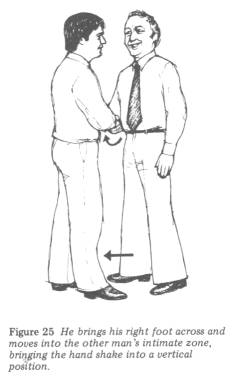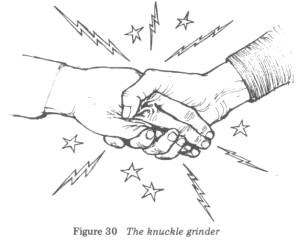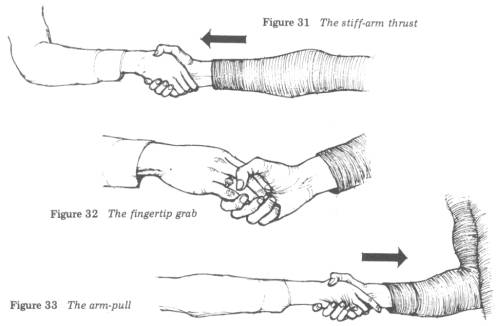Body Language: How to Read Others' Thoughts by Their Gestures (5 page)
Read Body Language: How to Read Others' Thoughts by Their Gestures Online
Authors: Allan Pease
Tags: #Popular psychology, #Advice on careers & achieving success, #Psychology

 When you receive a dominant handshake from another person, it is not only difficult to force his palm back over into the submissive position, but it becomes very obvious when you do it. There is a simple technique for disarming the dominant hand shaker that, in addition to giving you back the control, can enable you to intimidate the other person by invading his personal space. To perfect this disarmament technique you need to practise stepping forward with your left foot as you reach to shake hands (Figure 24). Next, bring your right leg forward, moving left in front of the person and into his personal space (Figure 25). Now bring your left leg across to your right leg to complete the manoeuvre, then shake the person’s hand. This tactic allows you to straighten the handshake position or to turn the other person’s hand into the submissive position. It also allows you to take control by invading the other person’s intimate zone.
When you receive a dominant handshake from another person, it is not only difficult to force his palm back over into the submissive position, but it becomes very obvious when you do it. There is a simple technique for disarming the dominant hand shaker that, in addition to giving you back the control, can enable you to intimidate the other person by invading his personal space. To perfect this disarmament technique you need to practise stepping forward with your left foot as you reach to shake hands (Figure 24). Next, bring your right leg forward, moving left in front of the person and into his personal space (Figure 25). Now bring your left leg across to your right leg to complete the manoeuvre, then shake the person’s hand. This tactic allows you to straighten the handshake position or to turn the other person’s hand into the submissive position. It also allows you to take control by invading the other person’s intimate zone.
Analyse your own approach to shaking hands to determine whether you step forward on your left or right foot when you extend your arm to shake hands. Most people are right-footed and are therefore at a great disadvantage when they receive a dominant handshake, asthey have little flexibility or room to move within the confines of the handshake and it allows the other person to take the control. Practise stepping into a handshake with your left foot and you will find that it is quite simple to neutralise a dominant handshake and take the control.


Who Reaches First?
Although it is a generally accepted custom to shake hands when meeting a person for the first time, there are some circumstances in which it may be unwise for you to initiate the handshake. Considering that a hand shake is a sign of welcome, it is important to ask yourself several questions before you initiate one: Am I welcome? Is this person glad to meet me? Sales trainees are taught that, if they initiate the handshake with a buyer on whom they call unannounced and uninvited, it can produce a negative result as the buyer may not want to welcome them and is forced to do something that he may not want to do.
Again, such people as arthritics and those whose hands are their profession may become defensive if they are forced to shake hands. Under these circumstances, sales trainees are told that it is better to wait for the other person to initiate the handshake and, if it is not forthcoming, to nod as a sign of greeting.
Hand Shake Styles
The palm-down thrust is certainly the most aggressive handshake style as it gives the receiver little chance of establishing an equal relationship. This handshake is typical of the aggressive, dominant male who always initiates it, and the stiff arm with palm facing directly downwards forces the receiver into the submissive position because he has to respond with his palm facing up.
because he has to respond with his palm facing up.
Several ways to counter the palm-down thrust have been developed. You can use the step-to-the-right technique (Figures 23 to 25), but sometimes this is difficult to use as the initiator’s arm is often tense and stiff to prevent such tactics. A simple manoeuvre is to grasp the person’s hand on top and then shake it (Figure 27). With this approach, you become the dominant party, as you not only have control of the other person’s hand, but yours is in the superior position on top of his with your palm facing down. As this can be embarrassing to the aggressor, we suggest that it be used with caution and discretion.

The glove handshake is sometimes called the politician’s handshake. The initiator tries to give the receiver the impression that he is trustworthy and honest, but when this technique is used on a person he has just met, it has the reverse effect. The receiver feels suspicious and cautious about the initiator’s intentions. The glove should only be used with people to whom the initiator is well-known.

Few greeting gestures are as uninviting as the dead fish handshake, particularly when the hand is cold or clammy. The soft, placid feel of the dead fish makes it universally unpopular and most people relate it to weak character, mainly because of the ease with which the palm can be turned up. Surprisingly, many people who use the dead fish are unaware that they do so, and it is wise to ask your friends to comment on your own handshake delivery before deciding which style you will use in future.


The knuckle grinder is the trademark of the aggressive ‘tough guy’ type. Unfortunately, there are no effective ways to counter it, apart from verbal abuse or physical action such as a punch on the nose!
Like the palm-down thrust, the stiff-arm thrust tends to be used by aggressive types and its main purpose is to keep you at a distance and out of the initiator’s intimate zone. It is also used by people brought up in country areas who have a larger intimate zone to protect their personal territory. With country folk, however, there is a tendency to lean forward or even balance on one foot when delivering the stiff-arm thrust.

The finger-tip grab is like the stiff-arm thrust that has missed the mark; the user mistakenly grabs the other person’s fingers. Even though the initiator may appear to have a keen and enthusiastic attitude toward the receiver, in fact he lacks confidence in himself. Like the stiff-arm thrust, the main aim of the finger-tip grab is to keep the receiver at a comfortable spatial distance.
Pulling the receiver into the initiator’s territory can mean one of two things: first, the initiator is an insecure type who feels safe only within his own personal space or second, the initiator is from a culture that has a small intimate zone and he is behaving normally.